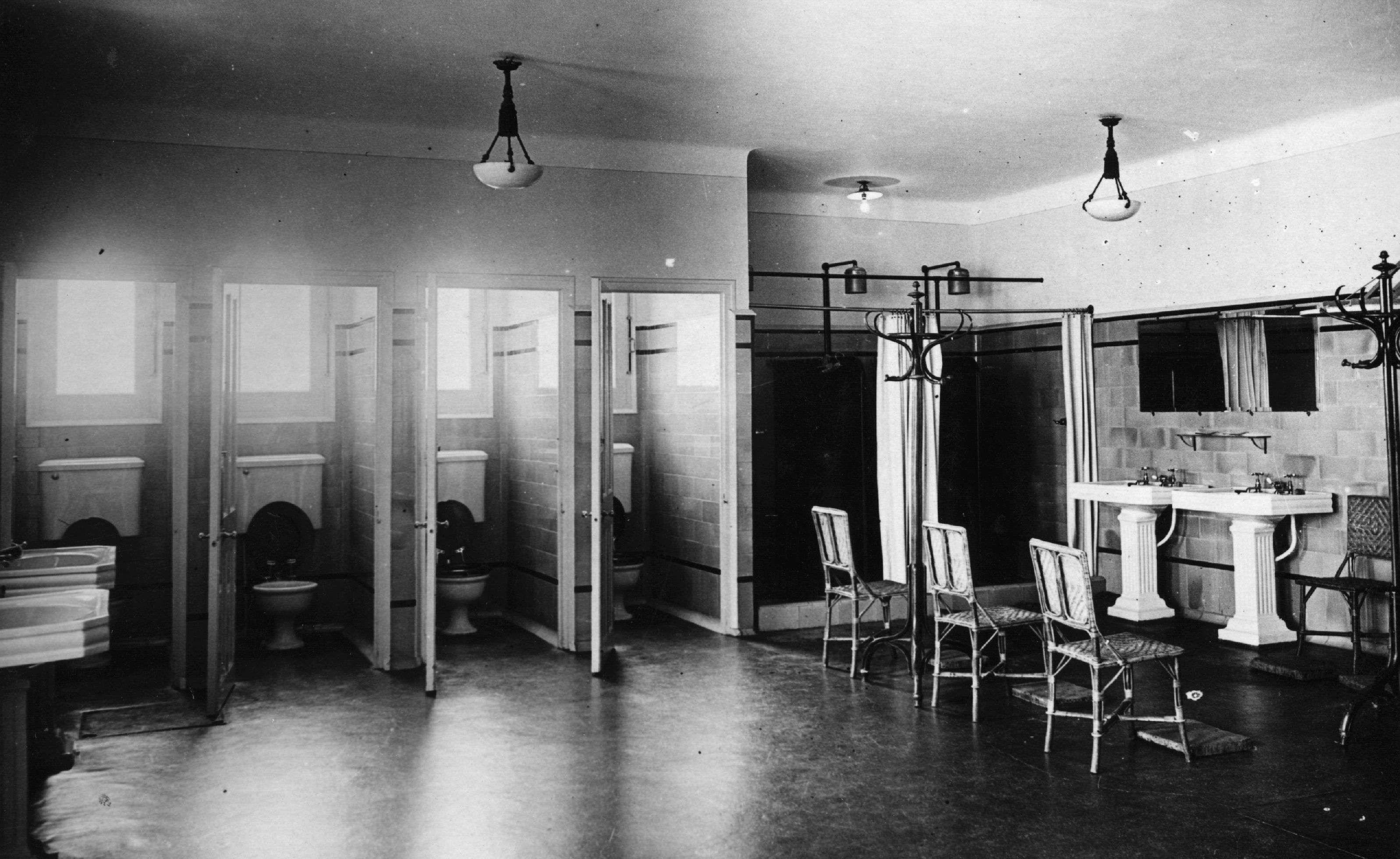A brief history of the ladies' bathroom
And how that history can shed light on America's suddenly fierce bathroom debate


Years ago, I went shopping for clothes with a friend and her mother. After trying on a few items, I walked out of the dressing room to find them waiting for me, laden with clothes, ready to check out.
"Aren't you going to try any of them on first?" I asked.
"We don't do that," my friend said. "We'll try them on at home and return the ones we don't want. We're not comfortable doing it at the store."
The Week
Escape your echo chamber. Get the facts behind the news, plus analysis from multiple perspectives.

Sign up for The Week's Free Newsletters
From our morning news briefing to a weekly Good News Newsletter, get the best of The Week delivered directly to your inbox.
From our morning news briefing to a weekly Good News Newsletter, get the best of The Week delivered directly to your inbox.
I was surprised. It was a nice enough store, and the ladies' dressing rooms were on the other side of the building from the men's. But these two women were not about to remove their clothing in public, even with the partition walls and locking doors.
There's a long history of women feeling ill at ease when expected to perform a private act in a public space, and this history is worth considering as the national debate rages over transgender individuals and bathroom laws. Comfort, privacy, and fear all played a part in creating our sex-segregated bathroom system, and will continue to influence whatever system we create going forward.
For men only
It took a really long time to convince women to pee in public. Mostly because, before the mid-1800s, the only public toilets were called "the street" and they were used almost exclusively by men. When ladies did go out, they didn't dawdle. There was nothing to linger for, really, outside of church or some other community meeting. Shopping wasn't fun. You handed the dry goods man your list of needed muslins and salt, he packed it up for you, and you headed home. If you had to go potty, you either held it, or found a nice grove of bushes or trees to relieve yourself, miles from anywhere public.
A free daily email with the biggest news stories of the day – and the best features from TheWeek.com
America was a nation of "Restrooms for customers ONLY!" And by restrooms, they meant holes dug in the ground to poop in. Saloons usually had privies out back, but ladies weren't allowed in saloons. There were a handful of other "public" latrines, but they were usually built and maintained by local businesses solely to keep people from befouling their buildings.
Not even with mahogany seats
In 1851, London held an enormous public fair called The Great Exhibition, where nations from all over the world displayed inventions and innovations. It was here that a plumber named George Jennings showed the world just how civilized public "retiring rooms" could be, even for ladies.
In Jennings' exhibit, a woman first entered a reception area and paid a penny to view the loo. Then she entered into the lavatory and was greeted by a row of sinks, much like in today's bathrooms. A matron took the ticket, answered any questions, and kept things tidy. Beyond the lavatory was a row of lovely toilets known as "closet rooms." They came with mahogany seats and seven-foot-high, floor-length partitions.
The exhibition was a hit. Thousands of women bought tickets to see these fancy new public toilets, to pull the cistern chain and watch the bowl be flushed clean by a crash of water. But there isn't any proof that the ladies used the toilets in their intended fashion. Because when Jennings later tried to take his retiring rooms mainstream, he failed. Women were curious about the concept, but not curious enough to relieve themselves in public just yet. They still felt vulnerable in these stalls. Naked, indecent, unsafe. Anyone who saw you entering the room would be free to imagine in great detail what you were doing in there, which was humiliating in an era where women were told that it was better to soil their skirts in mud than lift them and allow strangers to gawk at their shins. Women's bathrooms were not popular because society wasn't ready to accept them.
Indeed, we wouldn't be ready for the ladies' room until it was absolutely necessary.
The shopping fad
By the beginning of the 20th century, ladies' rooms were plentiful. But it wasn't that suddenly everyone became "tolerant" of the fact that women had digestive tracts. The entirety of the Industrial Revolution was called into play to make ladies' rooms possible. More women were working, which familiarized society with the sight of decent women outside the home. But the real change occurred when women, for the first time in history, began to enjoy shopping.
Factories were producing more leisure goods — beautiful fabrics and confectioneries and stationery supplies — which drew a more wealthy class of women out of their homes. They wanted to shop, to perambulate, perhaps visit all the new parks that were springing up, or even go to a museum. The outside world, which had been pretty much a men-only cesspit (literally) was now a place a lady felt welcomed to enter.
Women left the home and hit the street, but they certainly weren't about to pee in it. So, to attract the female money-spender, private businesses and even whole cities began building comfortable, secure areas where a woman could "retire."
That's not to say there weren't agitators and campaigners who had no financial gains in mind. Institutions like the Ladies' Sanitary Association were there, making noise. But it does seem that their message became easier to hear once it was harmonious with the sounds of cash registers.
The salient point is that it took decades for female bathrooms to become standard. Millions of people who might have been scandalized by women peeing in public had to be replaced by people who had never known anything else. It was those new women who agitated for change, and who felt comfortable doing something their grandmothers simply did not.
The inherent misery of pioneering
So where does that leave the transgender woman who would much rather endure the dirty looks of the ladies' room than the potential fists of the men's room? In a brutally unfair position, unfortunately. They are pioneers, and pioneers have never had an easy time of it. They live in a society that hasn't yet grown to accommodate them, just as ladies' bathrooms once didn't exist because society wasn't ready for women to pee in public. It sounds ridiculous, but that's how it is.
But it won't always be like this. The old ways die off, and new ideas spread to fit people's needs.
If there is one thing history has shown it is that you cannot force the majority to embrace your ideals overnight. ( Well, you can if you have enough tanks and machine guns. Stalin had pretty good results with this approach.) Change is all about patience. Having to wait for justice is intolerable, but absolutely unavoidable, as shown by the slow ascension of every minority and marginalized group to ever achieve equality. Like every outsider population that came before, there may be decades of battling, waiting, and great tribulation before society is ready. That isn't the work of evil people. It's the rhythm of the human species.
Therese O'Neill lives in Oregon and writes for The Atlantic, Mental Floss, Jezebel, and more. She is the author of New York Times bestseller Unmentionable: The Victorian Ladies Guide to Sex, Marriage and Manners. Meet her at writerthereseoneill.com.
-
 8 restaurants that are exactly what you need this winter
8 restaurants that are exactly what you need this winterThe Week Recommends Old standards and exciting newcomers alike
-
 ‘This is a structural weakening of elder protections’
‘This is a structural weakening of elder protections’Instant Opinion Opinion, comment and editorials of the day
-
 4 tips to safeguard your accounts against data breaches
4 tips to safeguard your accounts against data breachesThe Explainer Even once you have been victimized, there are steps you can take to minimize the damage
